Israel—the land of milk, honey, and guitar building. Obviously.
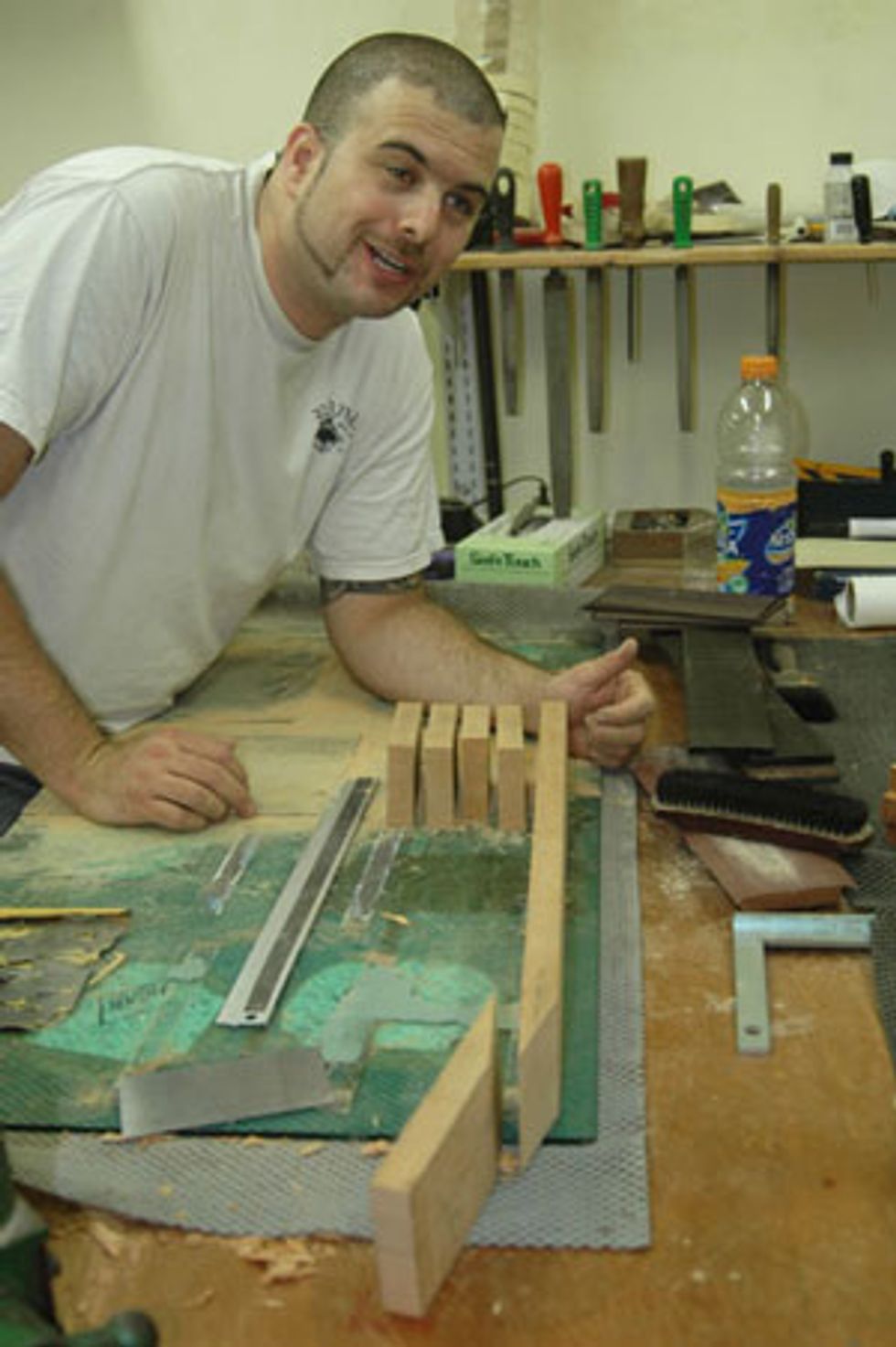
Tsahi Grimberg, an Israeli guitarist, technician,
and builder.
Modern Israel isn’t what most people expect. It isn’t a backwater of biblical ruins, a desert wasteland, or what you see in the news. Israel’s cities are diverse, cosmopolitan, and multicultural. They support a thriving and eclectic music scene and produce some of the world’s top artistic talents.
A small clique of repairmen and techs services Israeli musicians. They make modifications, suggest improvements, repair damage, service instruments, and—in a somewhat recent phenomenon—build new guitars.
Tsahi Grimberg, an Israeli guitarist, technician, and builder, introduced Premier Guitar to the Israeli luthier scene. “Over the last 10 years, a lot of people have started building guitars,” he says. “Israel has a very small market and some of these guys do great work. But they don't get any exposure.”
The Israeli scene is hyper-innovative, diverse, eclectic, and growing. It’s producing quality, high-end instruments, but it’s also a tight-knit scene. According to Grimberg, “It’s one big family. Everyone knows each other and hands off clients to each other.”
Premier Guitar spoke with a number of these Israeli builders to find out more about what’s happening in guitar on the other side of the planet.
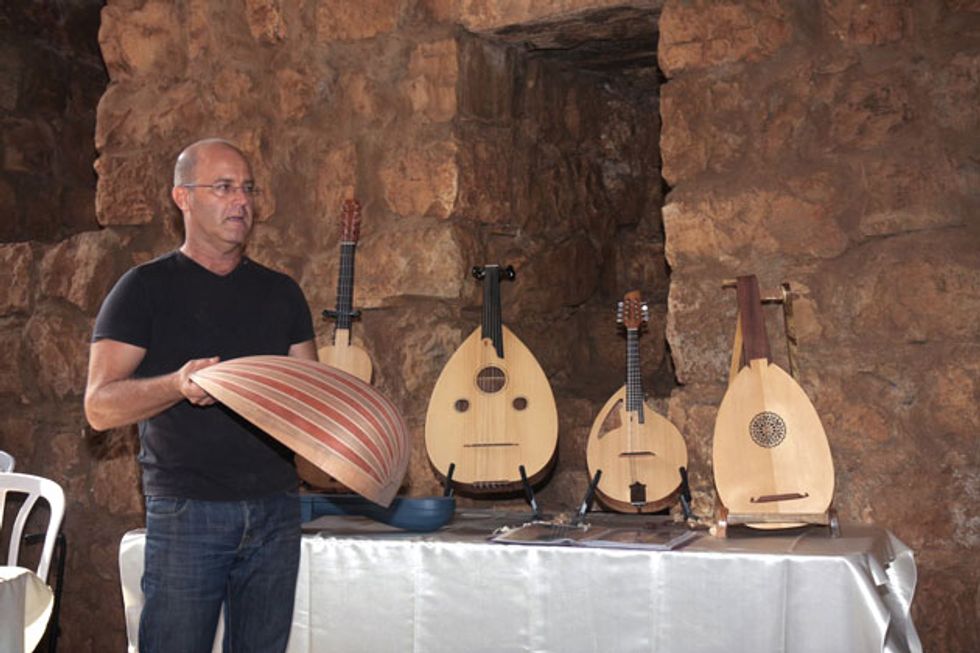
Yaron Naor Guitars
Yaron Naor lives and builds guitars in Bat Hefer, an Israeli village north of Tel Aviv and inland from Netanya.Naor’s guitar designs are quite innovative. Radical bracing, floating fretboards, unorthodox soundhole placement, and other features are attracting the attention of musicians and builders alike.
Naor builds acoustic and electric guitars, including bodiless, electric versions of traditional acoustic instruments, Baroque and Renaissance-era instruments, and new-fangled contraptions, such as an electric mandola-oud and a double-neck 9-string mandolin joined to an 11-string fretless guitar. His innovations aren’t just merely cosmetic—they aim to enhance the instrument’s tonal characteristics, boost dynamic performance, and improve playability. They make ergonomic sense, and he says some of them project significantly louder than other guitars. “Naor is Israel’s most innovative builder,” says Grimberg.
But guitar building wasn’t always on the radar for Naor, who studied industrial design at university and worked in high tech for 19 years. He bought his first guitar when he was in his early 40s (he’s 51 now). He wasn’t interested in becoming a virtuoso: He just thought it would be fun to strum chords at night around the campfire.
But Naor likes to tinker. He noticed that his guitar wasn’t perfect. It bothered him that his forearm stuck to the upper bout when strumming and that its edge left an annoying indentation in his skin. And the neck bothered him too—he thought it was too thick.
“I worked in industrial design,” Naor tells Premier Guitar. “I was supposed to solve these problems. I dealt with the interface between the machine and the operator. I thought about ergonomics. I made things comfortable.” He did that for machines, so why not for guitars? So he decided to build one.
It helped that his hobby was woodworking. “I spent a lot of time in New England for my job in high tech,” he says. “But I spent most of my time traveling to woodworking shops in Massachusetts, New Hampshire, and Maine.” He took classes. He talked to people to learn what they did. He accumulated a wealth of woodworking know-how and even had a woodworking studio in his house.
He knew how to work with wood by building cabinets and furniture, but woodworking and guitar building are different crafts. Naor didn’t know much about guitar construction and he wasn’t about to take a luthiery course in Cremona, Italy (home of Stradivarius and the mother of modern luthiery). So he read books, watched a few videos, and got to work.
Luthier Yaron Naor feels that X-bracing is unnatural, so he wanted to use a naturally occurring bracing scheme in his instruments. He found inspiration in the tree leaf. “A leaf is an example of natural bracing,” he says. “You have the main vein in the middle. It has joints and branches that grow off the stem.”
His friends, ever the cynics, told him it would take a year to build a guitar and it probably wouldn’t work. He finished in three months, and—surprise—it worked! Not only that, it sounded great.
“People said, ‘This guitar sounds fantastic,’” Naor remembers. “They asked me, ‘Who built this?’ And I said, ‘Me.’” He built four or five guitars based on his original designs, first for friends and then for clients. It was something he did at night after work. He didn’t quit his job in high tech yet—but he didn’t have time to make furniture anymore.
His original design had an unusual shape, but was otherwise a standard guitar. “I only changed the shape of the soundhole, contour, and shape of the headstock,” he says. “I didn’t make any changes to the structure, design, or the inside.”
But some things about traditional guitar design now bothered Naor, quirks that most people don’t question. He thought the soundhole was a problem. The guitar’s top, the soundboard, produces the guitar’s sound. It’s similar to a speaker cone. You wouldn’t cut a hole in a speaker, so why cut a hole in the middle of the soundboard? He asked other builders, but no one had a good answer. It was just something you did: The guitar has a hole in the middle—deal with it.
Worse, that hole weakened the top and necessitated additional bracing to keep the instrument from collapsing. Most builders use an X-shaped brace, but Naor doesn’t like it. He feels the X-shape isn’t an organic brace found in nature and it offends his aesthetic sensibilities.
Photo by Harry Suraski
Another problem was that most builders glued the part of the fretboard that extends past the joint where the neck is attached directly onto the soundboard. “That doesn’t make sense either,” Naor says. “Gluing the fingerboard to the soundboard is like sticking your finger on the speaker cone. You wouldn’t do that.”
His interest piqued, he got to work. He examined natural membranes. He looked at tree leaves. He collected about 100 leaves, dried them, scanned them, and looked at them in Photoshop. “I tried to find the repeatable pattern that you see in a leaf,” he says. “A leaf is an example of natural bracing. You have the main vein in the middle. It has joints and branches that grow off the stem.”
Naor wanted to try some of his ideas so he built an experimental guitar, developing a bracing system based on the bracing he noticed in these leaves. He created a fretboard that floats over the soundboard instead of touching it. He made the guitar in the shape of a teardrop and put soundholes in the upper and lower sides, near the neck joint. And he added a woodblock to make the instrument easy to play when seated.
He ran a few tests. He recorded samples, uploaded them to a sound-editing program, and compared them to samples of other instruments. According to his measurements, his guitar was 30 percent louder. It had better sustain, too. And it was a better sustain—the pitch stayed stable and didn’t warble or go flat as the note lingered. Plus, his guitar was comfortable and easy to play. It was properly balanced. He even rounded the upper bout so it didn’t dig into his forearm.
That experimental guitar was a watershed for Naor. He took those insights—leaf bracing, floating fretboard, unorthodox soundhole placement—and applied them to other instruments. He built ouds, mandolins, mandolas, classical guitars, and more. The results were the same: louder, more and better sustain, easy to play. He was onto something. His design aesthetic is most noticeable on fretless instruments, which often produce a quiet thud. Naor’s fretless guitars have increased sustain, volume, and full-bodied resonance.
Naor quit his high tech job in 2009 and now builds guitars full time, working alone to produce between 20 and 24 handmade instruments a year. He usually works on two or three instruments at a time, and one of those is usually experimental. He doesn’t have an assistant or an apprentice (though he does have students) and he hopes to keep it that way.
He builds his own jigs, bridges, and wooden tuners for his Baroque, Renaissance, and traditional instruments. “I make everything except for the strings and the machine heads,” he says. His aesthetic is minimal and his instruments have almost no ornamentation. “I like to keep it simple. I don’t like binding. I don’t like glue filling.” He doesn’t do fancy inlays either.
Naor also builds radical electrics guitars. In addition to solidbody electric guitars (including the Fenderson: Strat-style body, two humbuckers, and a Les Paul-scale neck), he builds bodiless electric versions of traditional Middle Eastern instruments and innovative hybrids. One example is a solution he devised for Israeli mandolin virtuoso Yaki Reuven.
The custom-made Mandolaoud for Yaki Reuven
Reuven found it a challenge trying to blend the mandolin’s high register in an ensemble of traditional Middle Eastern instruments. It was too shrill, and the frets made it difficult to play quarter-tones. Naor’s solution was the mandola-oud: a mandola (an alto mandolin, tuned a fifth lower) but fretless and with a ninth, undoubled bass string like an oud. The mandola-oud is electric and bodiless—it has just the wood outline of an oud body—with a piezo pickup under the bridge. The result is a rich, full-sounding, adaptable instrument.
Naor uses spruce tops for his acoustics—any spruce will do—and isn’t picky about the woods he uses for the bodies and necks. He can’t be, since most woods have to be imported into Israel. When he traveled for his high-tech job, he bought his wood overseas, but today he orders it online.
He says his biggest setback is Israel’s isolation. “If I lived in the States, I would have a waiting list,” he says. “I don’t have that in Israel. The market just isn’t big enough.”
Despite that challenge, Naor is a full-time builder who has the freedom to innovate and experiment.
Johny Tsfaty only builds what he wants. “If a customer really wants a Les Paul, Johny won’t build it,” says Tsahi Grimberg. “He tells him where he can get a Les Paul.”
Bloody Johny Guitars
Johny Tsfaty is Bloody Johny Guitars. His instruments have radical shapes, unusual inlays, LED-illuminated fretboards, an über-hip ox skull logo, and are available in colorful and diverse tonal choices. Tsfaty’s customers tend to be metalheads and bass-thumping funkateers, though he says he’ll build anything for anyone.His instruments aren’t all about looks though—Tsfaty wants them to be versatile, playable, and personal. The hallmark of Bloody Johny Guitars is his distinctive, one-of-a-kind stamp. “I create solutions and solve problems,” Tsfaty tells Premier Guitar. “I build something unique, tailor-made for that customer.”
Tsfaty got his start winding pickups, but found that work to be monotonous. (Or as he put it, “I got really bored winding pickups.”) He learned carpentry as a kid and had a knack for it. “I played in a band and loved the guitar,” he says, “but I realized that my contribution was going to be as a craftsman, not as a performer.”
He decided to give guitar building a shot. He read Building Electric Guitars by Martin Koch and got to work. He also befriended Herzel Raz, known as Israel’s guitar doctor and a legend within Israel’s insular circle of guitarists, repairmen, and builders. Tsfaty showed Raz his guitar at different stages during the build, and Raz offered advice and encouragement. That first guitar was a success. “I thought it was going to be a disaster,” he says. “But it wasn’t. My friends kept borrowing it. They’re still borrowing it.”
—Johny Tsfaty
He built guitars for friends, his friends told friends, and soon Bloody Johny Guitars was open for business. Tsfaty’s business model is casual. “It isn’t like New York where everyone is formal,” he says. “Israel is informal and it’s an easy way to get things done.”
Tsfaty’s first meeting with a customer is like a hangout: They listen to music, drink coffee, and talk guitars. Next, he watches the customers play, observing how they sit and hold the guitar. He looks for quirks and idiosyncrasies and tries to understand his customers’ playing style. He makes a mock-up—a first draft of the design—and uploads that to his computer. They email back and forth, discuss the instrument, make improvements, and meet a few more times. The process takes about three weeks. “Once I have the simulation and full specs, then I start building,” Tsfaty says. “I argue with my customers, too, if it’s what is best for the instrument. Though they don’t always agree with me.”
Tsfaty’s instruments are handmade. He uses electric tools for the obvious stuff—cutting the rough body shape, routing the cavity for the electronics—but otherwise he uses manual tools: planes, knives, chisels. “Working this way is best for a small shop like mine,” he says. “I have the most control. In a big factory, making thousands of instruments, a glitch isn’t a big deal. You can just discard it. But I don’t have that luxury.”
Like other Israeli builders, Tsfaty can’t be too picky about wood. Basic woods such as mahogany, maple, walnut are available, as are some African woods. But exotic tone woods and figured woods are rare and cost a fortune to import. “Just the raw wood can cost $250,” says Grimberg.
Johny Tsfaty's Earth bass.
Scarcity and limitations of materials is a big challenge, but not the biggest one. Tsfaty finds that Israel’s small music scene makes it difficult to earn a living just building instruments. Most take other work doing setups, repairs, and mods. And some builders have day jobs (Tsfaty builds cabinets).
But despite this, the scene isn’t cutthroat. Israeli builders stick together and even send each other business. In a way, those limitations give them freedom. “Johny Tsafty only builds what he wants,” Grimberg says. “If a customer really wants a Les Paul, Johny won’t build it. He tells him where he can get a Les Paul.”
Tsfaty only builds about six guitars a year, and the customer is involved in every step of the process. “I’m not selling a guitar,” Tsfaty adds. “I’m selling a relationship. I have a lot of musician friends now.”
Waiting for building materials is a major challenge for Israeli luthiers, says Benjamin Millar. “How long is up to the Israeli postal service,” Millar says. “It can be a slow process.”
Benjamin Millar Guitars
Benjamin Millar Guitars is based in Givatayim, a city just east of Tel Aviv. Millar has a small shop where he does repairs, mods, and setups, but building is his passion because he likes pushing himself. He builds instruments that other builders won’t attempt and his clients include Oriental rocker Yossi Sassi and bassist Or Lubianiker (Marty Friedman, Gus G.).Millar started out in the early 2000s. He was in a band and one of their guitars needed work. “I made a few modifications,” he tells Premier Guitar. “I made a few weird mistakes, too.” He worked in piano restoration, a job that gave him access to a workshop and tools, and took a guitar-building program at the Algranati School, a one-year luthiery course based in Ramat HaSharon. The teachers at Algranati liked Millar and hired him to do setups and repairs after he completed the program. Between piano restoration and working for Algranati, Millar honed formidable guitar-building chops and went solo in 2009. He opened his small shop, kept doing repairs, and built a few instruments for friends. In the past five years, he’s built up a base of clients.
One of Millar’s more radical designs is the Bouzoukitara, a doubleneck bouzouki-guitar combo he built for Yossi Sassi. Sassi often switches instruments mid-song—a reason many people choose to use doublenecks—but he also wanted to preserve the integrity of an acoustic bouzouki alongside a solidbody electric. Millar’s creation does just that: A traditional, acoustic bouzouki is fused to a solidbody electric. The instrument looks like a normal doubleneck from behind, but two separate instruments from the front.
The first Bouzoukitara was built in 2011. After a few years of use live and in the studio, Sassi wanted an upgrade. The next generation, the YS-II, is a leaner, meaner Bouzoukitara. It’s smaller, lighter, thinner, and easier on the body. Millar set the different necks at different angles. He sloped the upper bout inward, making it easier to pick. He also upgraded the electronics to give Sassi more sonic control.
Millar’s instruments are handmade and he works alone, but he finds the environment stimulating. “When you build a completely new instrument—an instrument that doesn’t have a reference model—you’re the only one who can say if it’s good or if you should wait,” he says. “It’s a constant mind struggle. But that’s why I like this—you don’t stagnate.”
He likes building the guitars, but he doesn’t like ordering materials. Waiting for parts creates an unnatural lull. “You agree to a design, you collect the money, you place the order, and you wait,” he says. “How long is up to the Israeli postal service. It can be a slow process.”
One of Benjamin Millar’s more radical designs is the Bouzoukitara, a doubleneck bouzouki-guitar he built for Yossi Sassi in 2011. After a few years, Sassi wanted an upgrade. The new guitar, the YS-II, is a leaner, meaner Bouzoukitara. It’s smaller, lighter, thinner, and easier on the body.
Millar also has trouble getting equipment. Guitar-building tools are very specific and not available in a small market like Israel, and taxes and tariffs can often double the price. Millar makes do, but some Israeli builders improvise. “For most situations, we find solutions,” Grimberg adds. “But that may mean building your own tools. You have to be creative.”
Millar is optimistic. He has a great reputation for building high-end instruments, and his business is growing. Plus—and he thinks this is significant—he’s growing a healthy beard. “I’ve noticed that the longer my beard gets, the better my builds.”
The Future
The guitar-building community in Israel is relatively small. “Israeli luthiery is in its infancy,” says Naor. “We don’t have a hundreds-of-years tradition.” But Israel is catching up. Israeli builders are innovating, experimenting, and producing quality instruments. Builders are frustrated by some limitations within their country, but no one is thinking of leaving. “Every builder would love to go to the States because the market is so much bigger,” Grimberg says. “But we stay because Israel is home.”
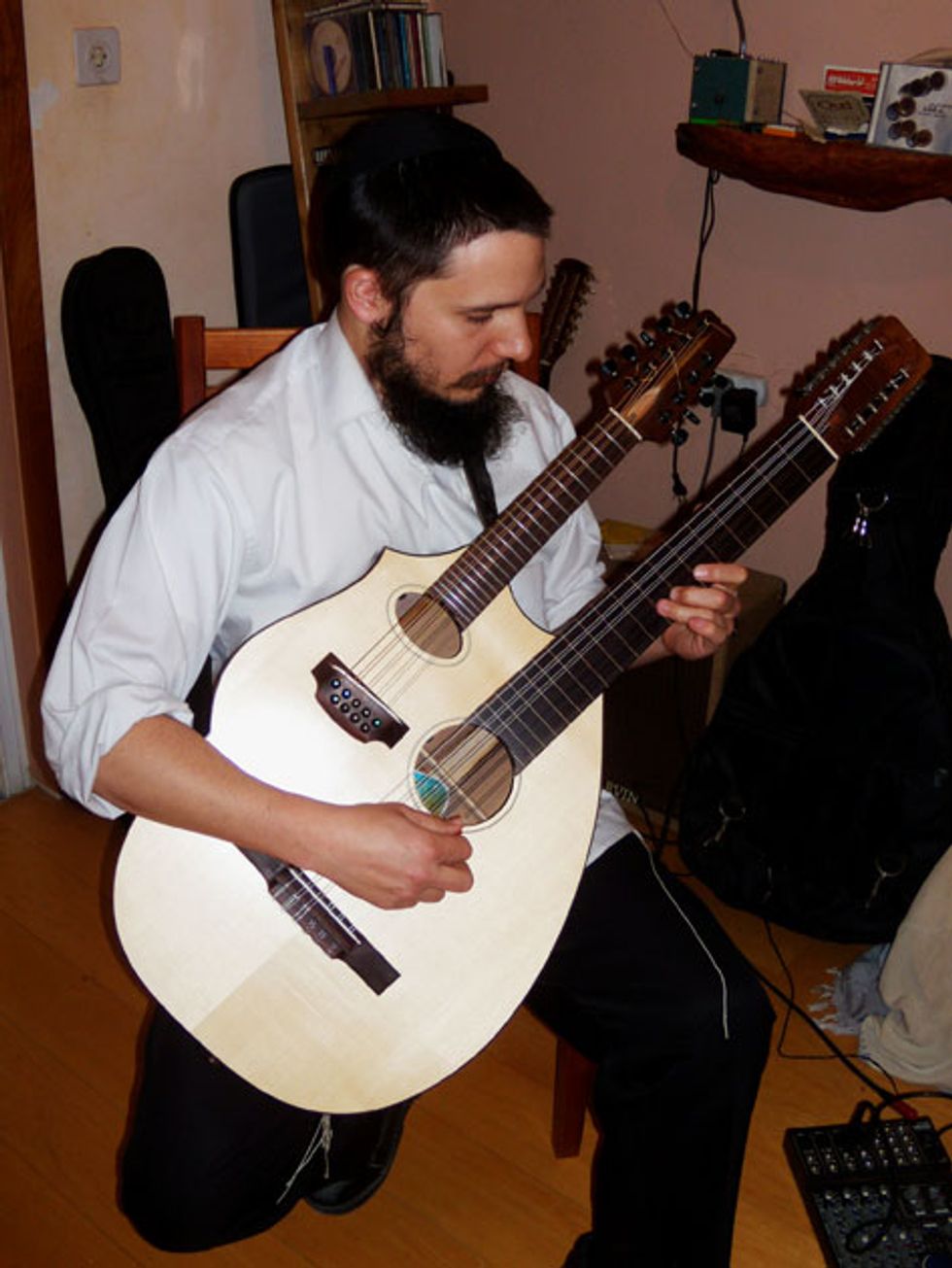
Transitioning Between Tones
Nadav Bachar is an Israeli multi-instrumentalist who plays the guitar, oud, and other Middle Eastern instruments. His music often necessitates switching instruments mid-song. That can be confusing, especially since the instruments are tuned differently. He needed an instrument that would let him transition between sounds more easily, with at least two necks in standard guitar tuning, but designed to mimic the timbres of the oud and other non-guitar sounds.Bachar heard that Yaron Naor did good work and that his prices were reasonable. They met, discussed the instrument, felt a connection, and decided to give it a try. “I explained my fantasy and he told me what he could do,” Bachar tells Premier Guitar. “Naor explained the different obstacles he would have and what was possible and what wasn’t.”
They built a doubleneck 9-string mandolin/11-string oud. The upper neck, the mandolin, is tuned E–A–D–G–B and except for the low E, the upper four strings are doubled. The lower neck, the oud, is fretless and tuned like a standard guitar. The upper five strings are doubled (not in octaves like on a 12-string guitar but in unison like on an oud). Each bridge has an under-saddle piezo pickup.
Watch Bachar and his special instrument in action.
Naor had to experiment to get the bracing right. “The tension of 20 strings is very strong, and we didn’t know what it could handle,” Bachar says. “It took a few attempts to figure that out.” It also took a few live performances to settle on the best way to configure the pickups. Each neck can be isolated or ring in sympathy with the other.
“You need to be crazy if you want to build that kind of instrument,” Bachar adds. “It’s an adventure. You don’t know what is going to be.”
But it seems to have worked out for everyone involved. The result is a typical Naor creation: leaf bracing, easy to play, minimal ornamentation. According to Bachar, it has a full, rich sound and—unlike most fretless guitars—the fretless neck boasts warm tones and significant sustain.




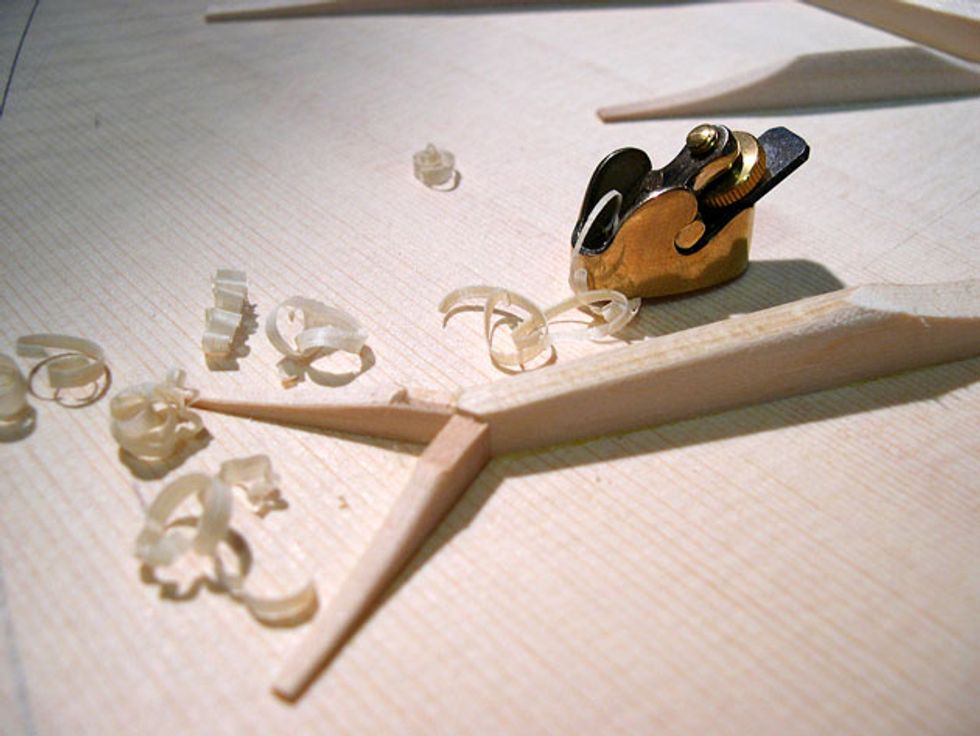
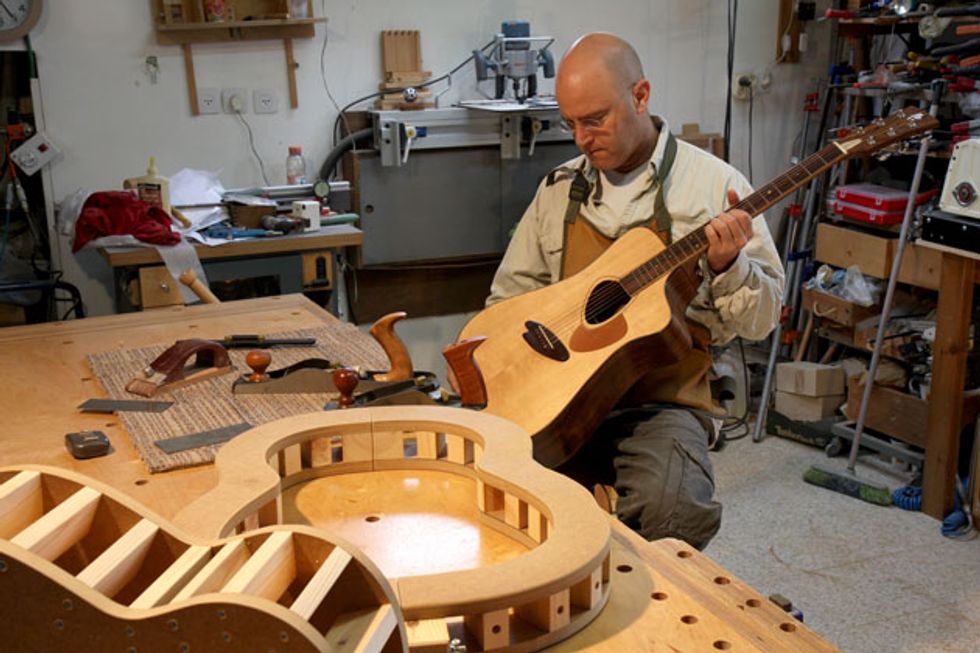
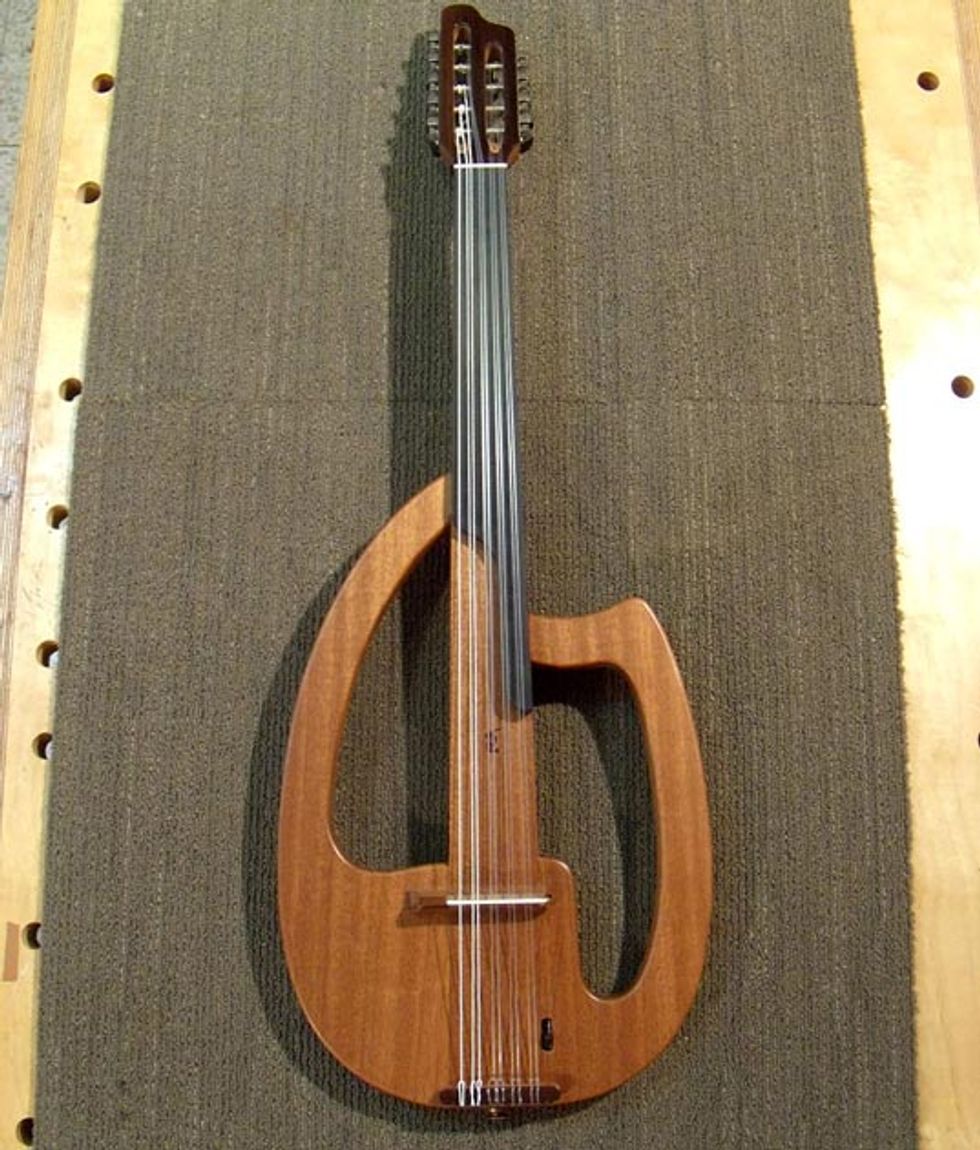


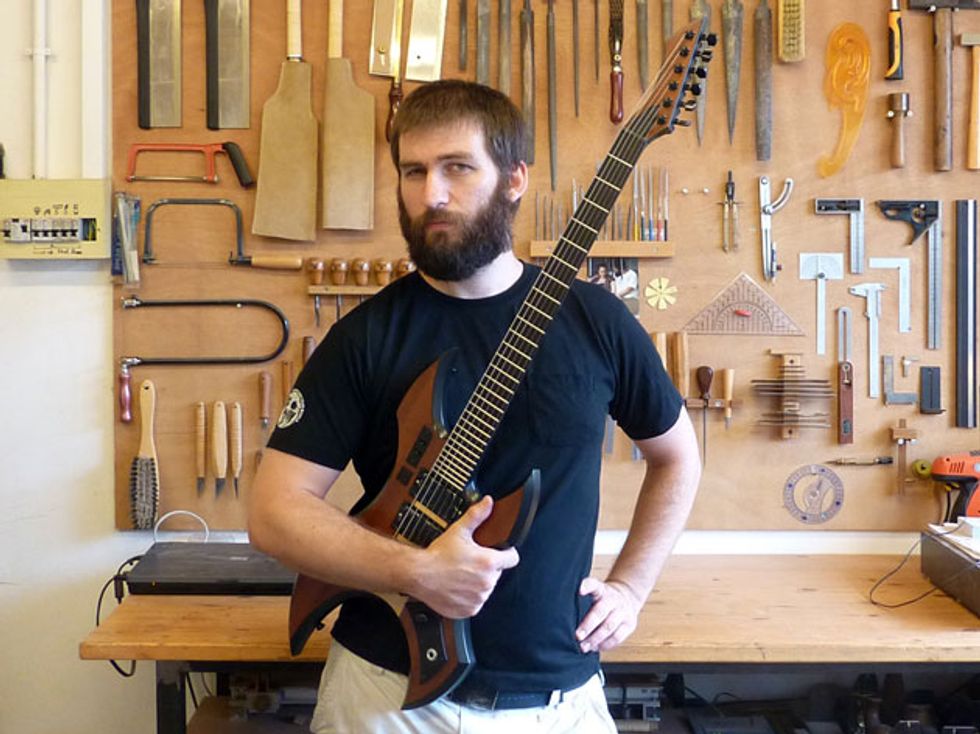
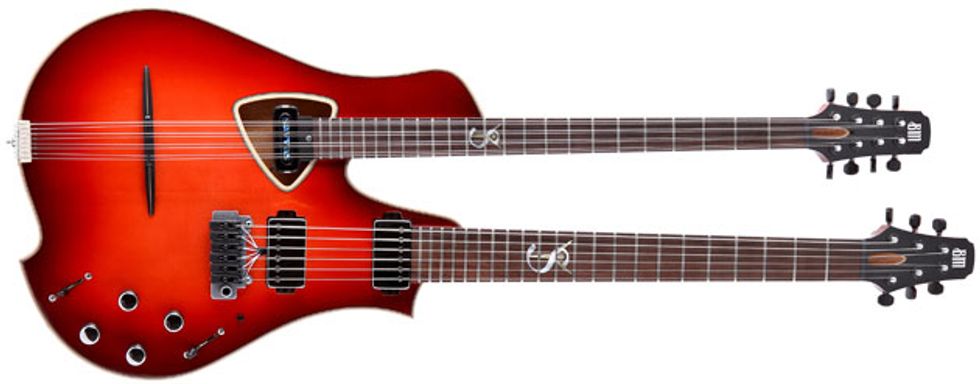






![Rig Rundown: Russian Circles’ Mike Sullivan [2025]](https://www.premierguitar.com/media-library/youtube.jpg?id=62303631&width=1245&height=700&quality=70&coordinates=0%2C0%2C0%2C0)
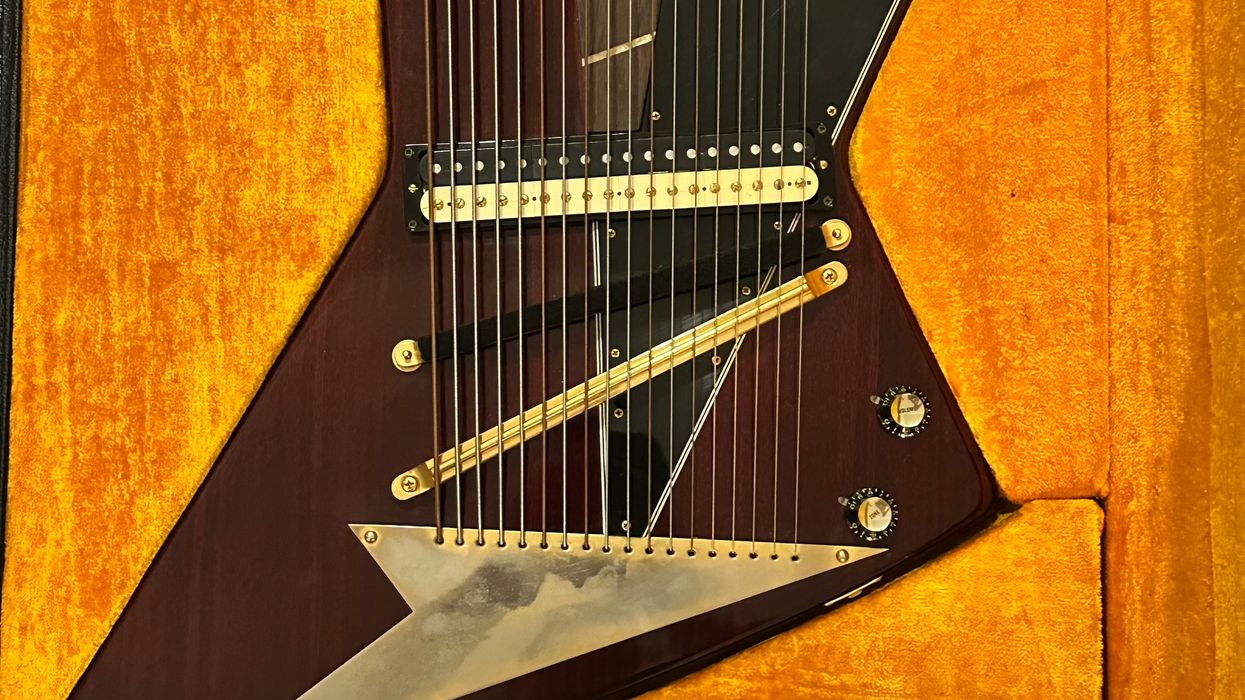
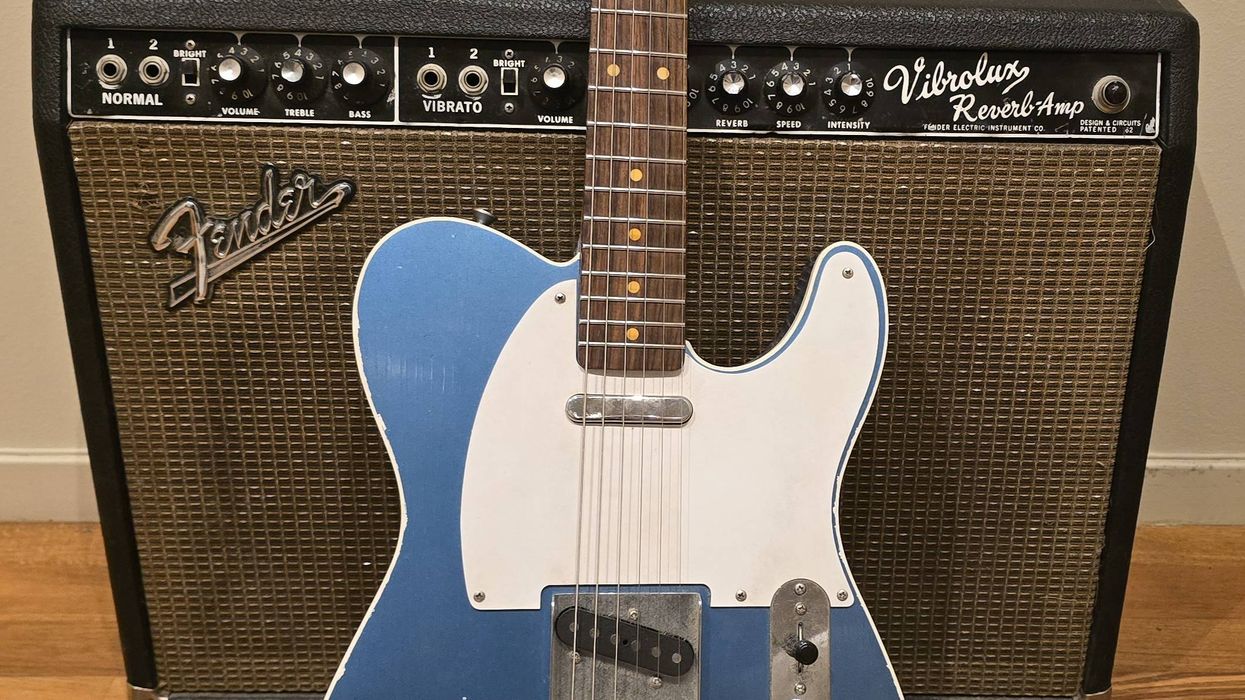
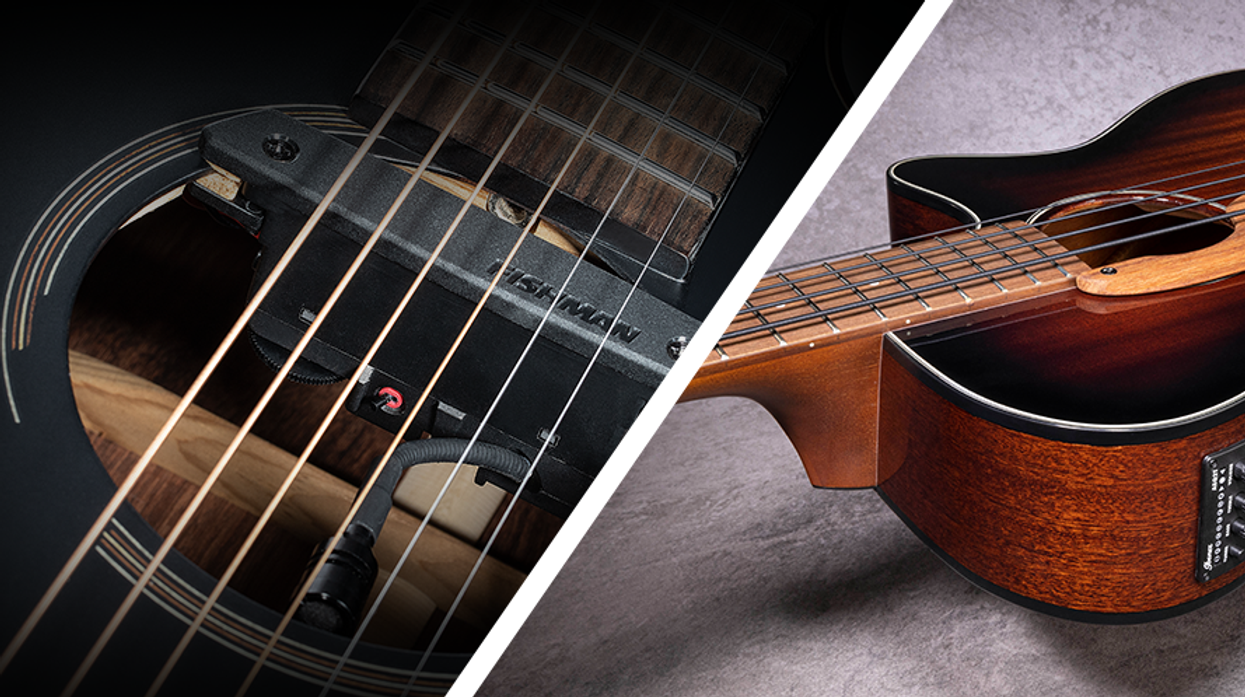
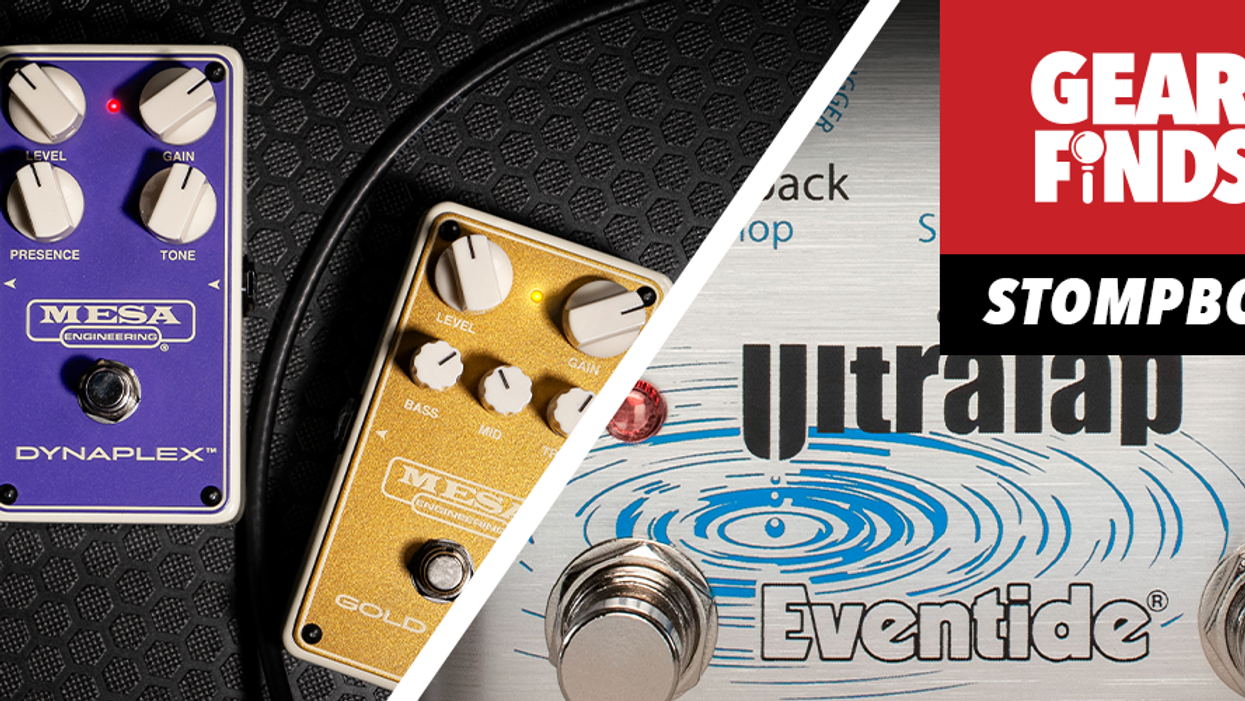










![Rig Rundown: AFI [2025]](https://www.premierguitar.com/media-library/youtube.jpg?id=62064741&width=1245&height=700&quality=70&coordinates=0%2C0%2C0%2C0)




















 Zach loves his Sovtek Mig 60 head, which he plays through a cab he built himself at a pipe-organ shop in Denver. Every glue joint is lined with thin leather for maximum air tightness, and it’s stocked with Celestion G12M Greenback speakers.
Zach loves his Sovtek Mig 60 head, which he plays through a cab he built himself at a pipe-organ shop in Denver. Every glue joint is lined with thin leather for maximum air tightness, and it’s stocked with Celestion G12M Greenback speakers.











